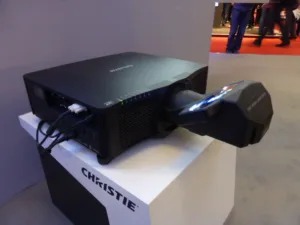Big news in projection for Christie was the launch of the HS Series, which currently consists of two models: the D12HD-HS and D12WU-HS (Christie Teases ISE Models). The company says that it has ‘solved’ the colour balance problem of laser phosphor using RGBY colour wheels spinning at three times the standard speed.
Product manager Curtis Lingard explained that spinning the colour wheel at three times the standard speed (10,800 RPM) “greatly reduces” colour separation, also known as the rainbow effect. At this speed, most people won’t be able to detect the anomaly at all.
The projectors also feature what Christie refers to as ‘BoldColor’ technology; the company will soon release a white paper on the topic. Rather than a single solution, the technology is the result of several factors working together, including the laser light source, optical path components, image processing and software. It does, however, rely on the laser diode as a reliable source of illumination.
BoldColor is designed to deliver improved colour at high levels of brightness. Lingard said, “By starting with light from both red and blue laser diodes to increase the colour balance of the gamut, we’re able to increase colour accuracy without using significantly more power.
“The lasers are just the start. Christie’s unique design of the rest of the optical system and the software that manages the entire system work in unison to optimise brightness, colour accuracy and colour balance simultaneously. This approach means that the red segment of the colour wheel can be exposed for less time, allowing more time for other segments. The result is higher light output as well as highly-accurate colours which can meet the Rec. 709 standard for high-definition colour reproduction.
“It isn’t just the ability to meet the Rec. 709 standard, but also the resulting improved colour balance that ensures images are bold and realistic. That’s the key. It’s relatively easy to hit the desired colour coordinates, but to have superior driving power behind the colours is what really makes BoldColor technology bring the images to life.”
ANSI lumen ratings in the HS series are 11,500 (D12HD) and 10,500 (D12WU). Both have 1920 x 1080 resolution, will reach half brightness at 20,000 hours and feature 1DLP technology. They have DVI-D and 3G-SDI inputs. The projectors measure 509 x 677 x 203mm and weigh 42.5kg.
Additions were also made to the Q Series (also covered in the article above). These are dual-lamp units, which have now reached a higher brightness level. Last year, the top-brightness model was the DXG1051-Q, at 10,000 lumens, with a gap of 1,500 lumens to the step-down DWU951-Q (8,500). The 2016 models fill that space, with brightness levels of 8,900 lumens (DHD1052-Q and DWU1052-Q). They will be shipped in April.
Christie’s main announcement was regarding a new range of LED tiles called Apex. These are 1.2mm- and 1.6mm-pitch tiles, designed for 24/7 mission-critical applications including control rooms. Cotnrol rooms typically use lower brightness at around 350 cd/m² and with badly controlled LEDs, the blacks can be “crushed”, but Christie has a solution to this in its driving. The LED modules are front-accessed through a magnetic latch and feature a redundant power supply. In addition, the memory-on-module function saves calibration data, so after repairs or replacements, new tiles will automatically calibrate to saved settings.
The Apex tiles reach 1,000 cd/m² and will be shipped in April, with orders being taken now. Warranty is three years and Christie is happy to quote for up to six years. The current Velvet range will be re-branded as Velvet Merit.

